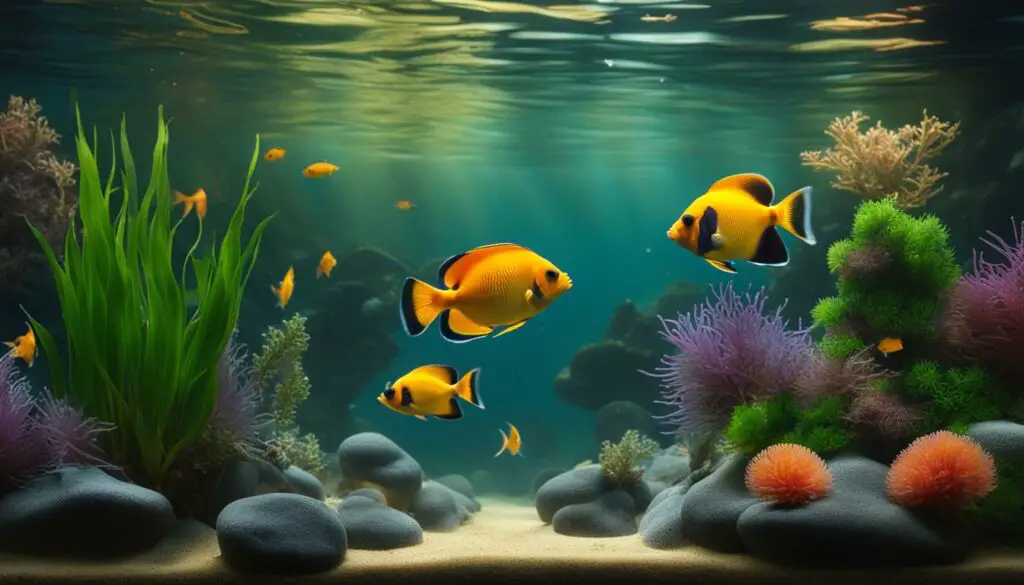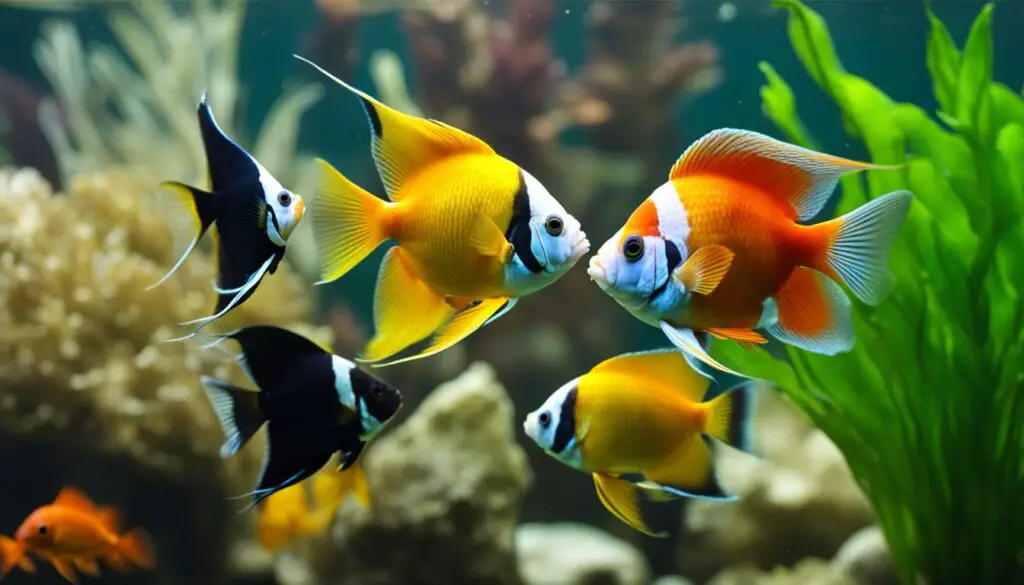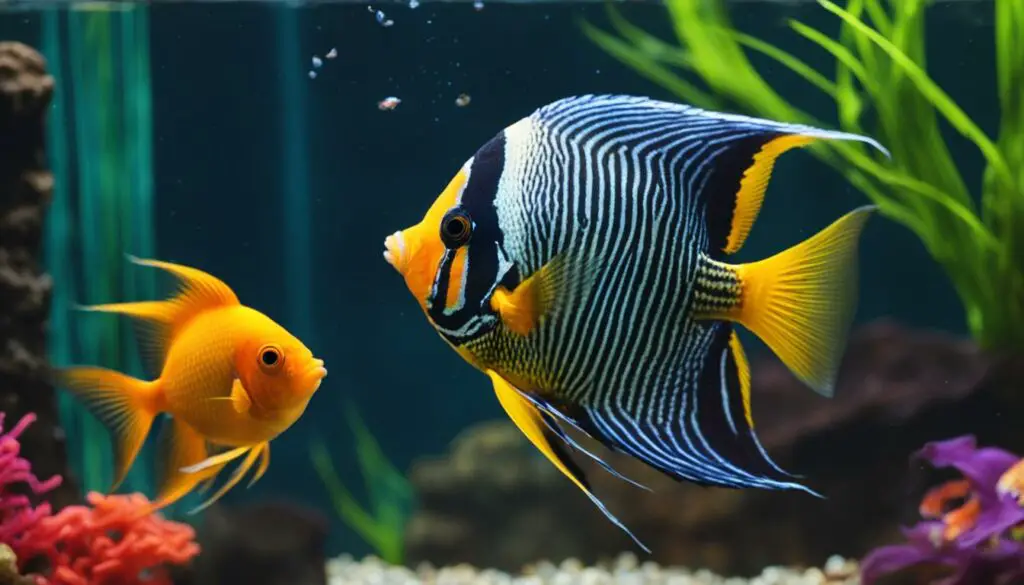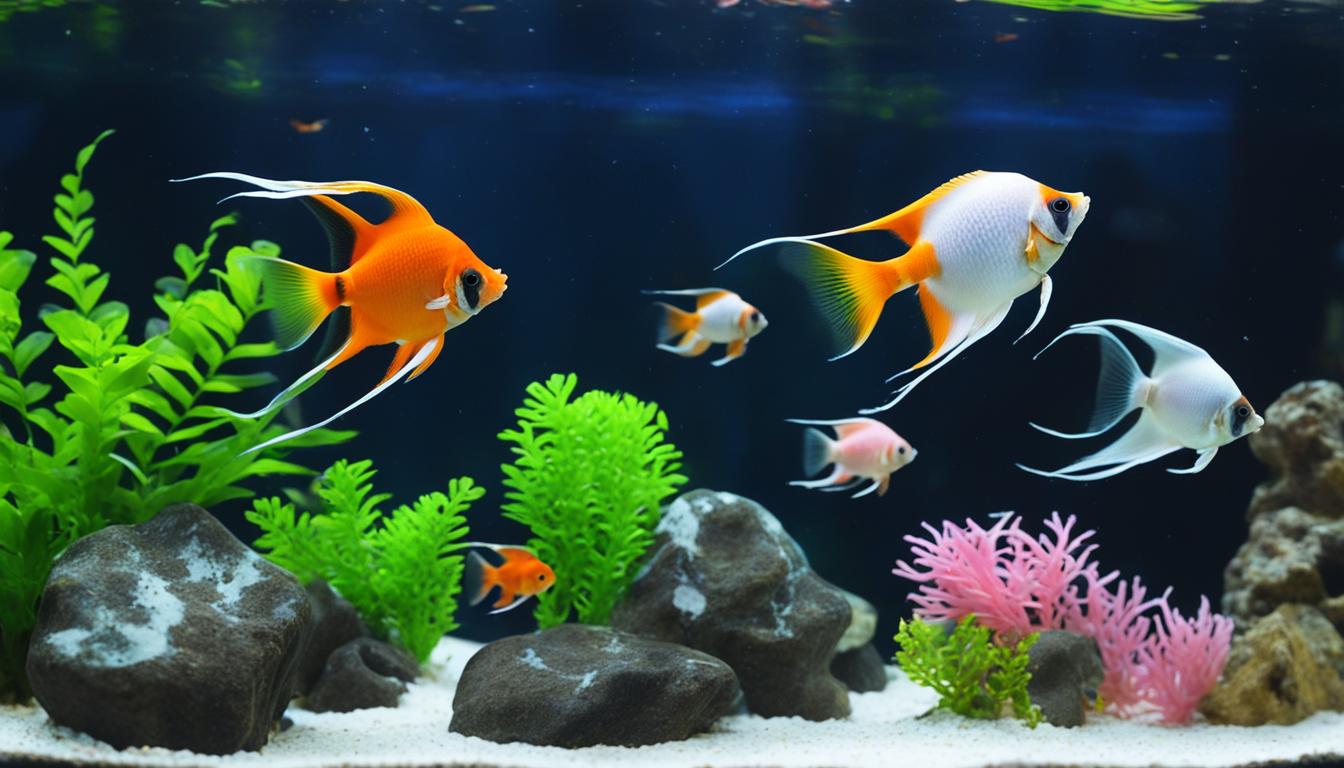Last Updated on 5 months by admin
Angelfish and goldfish are popular choices for aquarium enthusiasts, but can they live together in the same tank? In this article, we will explore the compatibility between angelfish and goldfish, considering their care requirements and behaviors. Let’s dive in and find out if these two species can cohabitate successfully.
Key Takeaways
- Angelfish and goldfish have different care requirements and preferences.
- Angelfish are tropical fish that require warmer water temperatures, while goldfish are coldwater fish that prefer cooler temperatures.
- Angelfish are aggressive and territorial, while goldfish are peaceful.
- Creating a suitable environment for both species in the same tank can be challenging due to differences in temperature and behavior.
- It is recommended to keep angelfish and goldfish in separate tanks to ensure their well-being.
The Difference in Water Conditions

When it comes to creating a suitable environment for angelfish and goldfish, understanding their water requirements is crucial. These popular aquarium fish have distinct preferences when it comes to temperature and pH levels.
“Providing the right water conditions is essential for the health and well-being of your fish.”
Angelfish are tropical fish and thrive in warmer water conditions. They prefer temperatures between 75-86°F (24-30°C). On the other hand, goldfish are coldwater fish and prefer slightly cooler temperatures between 65-75°F (18-24°C).
In addition to temperature, the pH level of the water is an important factor to consider. Angelfish prefer softer water with a pH level between 6.0-7.5. Goldfish, on the other hand, prefer slightly alkaline water with a pH level between 7.2-7.6.
To summarize:
| Fish | Temperature Range | pH Level |
|---|---|---|
| Angelfish | 75-86°F (24-30°C) | 6.0-7.5 |
| Goldfish | 65-75°F (18-24°C) | 7.2-7.6 |
As you can see, these differences in water conditions pose a challenge in maintaining a harmonious tank environment for both angelfish and goldfish. It is best to provide separate tanks with appropriate water conditions to ensure the optimal health and happiness of your fish.
Tank Dimension: Heights for Angels vs Wides for Golds

When it comes to tank dimensions, it’s important to consider the needs of your fish. Angelfish and goldfish have different body shapes and swimming preferences, which influence the ideal tank size for each species.
Angelfish have a vertical body profile with long fins, making them graceful swimmers that require ample vertical swimming space. On the other hand, goldfish have a rounder body shape and prefer to swim horizontally, needing more wide open spaces in their tank.
To provide a comfortable and stress-free environment for both species, it is recommended to cater to the specific space requirements of each. Here is a comparison of the tank dimensions that best suit angelfish and goldfish:
| Species | Ideal Tank Shape | Tank Size |
|---|---|---|
| Angelfish | Taller tank | At least 20 gallons |
| Goldfish | Wider tank | Minimum 10 gallons per goldfish |
Providing the right tank dimensions for angelfish and goldfish allows them to swim and explore comfortably. It also helps avoid overcrowding, which can lead to stress, aggression, and health problems for the fish.
Competition for Food

When it comes to keeping angelfish and goldfish together in the same tank, one of the key challenges is the competition for food. Both angelfish and goldfish have similar dietary requirements as omnivores, which means they eat a variety of foods, including flakes, pellets, frozen foods, and live foods.
With these similar feeding requirements, having both angelfish and goldfish in the same tank can create a situation where one species dominates the food supply while the other species is left underfed. This can lead to malnutrition and health issues for the fish, compromising their overall well-being.
“Having both angelfish and goldfish in the same tank can result in one species dominating the food supply and the other species being underfed. This can lead to malnutrition and health issues for the fish.”
In order to ensure that both species receive adequate nutrition, it is recommended to either separate them into different tanks or carefully monitor their feeding patterns.
Feeding the fish separately can help alleviate the competition for food. You can use a divider in the tank or feed them in separate tanks altogether. This way, each species can enjoy their meals without the stress of competition.
Feeding Tips for Angelfish and Goldfish:
- Provide a balanced diet: Offer a mix of high-quality flakes, pellets, and occasional live or frozen foods to meet the nutritional needs of both angelfish and goldfish.
- Feed in small portions: Split the daily feeding into multiple small portions to prevent overeating and reduce the chance of food dominance.
- Monitor feeding behavior: Observe how each fish feeds to ensure that both angelfish and goldfish have equal access to the food. If one fish is constantly dominating the feeding area, consider adjusting the feeding arrangements.
Awareness and careful attention to the feeding habits of angelfish and goldfish can help create a harmonious tank environment and maintain the health and well-being of both fish.
Mannerisms

Angelfish and goldfish have distinct mannerisms and behaviors. Understanding these differences is crucial when considering housing them together in the same tank.
Angelfish territorial behavior:
Angelfish, known for their territorial nature, can exhibit aggression, especially as they mature. They establish and vigorously defend their territories, often resulting in hostility towards other fish sharing the tank. This innate territorial behavior can pose a significant challenge when attempting to keep angelfish and goldfish in the same tank.
Goldfish behavior:
Goldfish, on the other hand, are generally peaceful by nature. However, it is important to note that they can become territorial in specific circumstances, particularly when abrupt changes occur in the tank environment. These changes may trigger defensive behavior and territorial aggression. Therefore, when considering pairing goldfish with angelfish, caution is advisable.
“Angelfish and goldfish have opposing behaviors when it comes to territoriality, making it significantly harder for them to coexist peacefully in the same tank.”
It is essential to prioritize the well-being and stress levels of both fish species. Therefore, it is generally recommended to house angelfish and goldfish separately to ensure their optimal care and minimizing any potential harm or stress.
Mannerisms at a Glance
| Species | Territorial Behavior | Aggression Tendency |
|---|---|---|
| Angelfish | Territorial, establish and defend their territories | Potential for aggression, particularly as they mature |
| Goldfish | Generally peaceful, with occasional territorial tendencies | Territorial aggression may occur due to sudden environmental changes |
The Difference in Aquarium Size

When considering keeping angelfish and goldfish together, it is important to understand the difference in tank size requirements for these species. Goldfish are known to grow quite large and require ample space to thrive. A general recommendation is to provide 10 gallons of water per goldfish. This ensures they have enough room to swim, grow, and maintain optimal health.
Angelfish, on the other hand, do not require as much space individually. However, they have specific space requirements due to their unique body profile and territorial behavior. Angelfish have a vertical body shape and need ample vertical swimming space. They also appreciate the availability of hiding spots to establish their territories. The tank should be tall enough to accommodate their vertical swimming habits, but it doesn’t necessarily need to be as large in terms of gallons.
Combining angelfish and goldfish in the same tank poses challenges in terms of tank size. Trying to accommodate both species may lead to overcrowding, limited swimming space, and increased stress for the fish. Therefore, it is recommended to provide separate tanks for angelfish and goldfish to ensure each species has enough space to thrive.
However, if you are determined to have a mixed community tank, it is crucial to choose a tank that meets the larger tank size requirements of goldfish and provides enough vertical space and hiding spots for angelfish.
| Species | Tank Size Requirement |
|---|---|
| Goldfish | 10 gallons per goldfish |
| Angelfish | Taller tank for vertical swimming and hiding spots |
Creating a suitable and spacious environment for both angelfish and goldfish is essential for their well-being. By providing adequate tank size and space, you can ensure that each species has the room they need to thrive and minimize any potential conflicts or stress.
Can Angelfish Kill Goldfish?

While it is rare for angelfish to kill goldfish, aggression between the two species is a possibility. Angelfish may exhibit aggressive behavior towards goldfish, especially if the goldfish are smaller in size. However, it is unlikely for angelfish to actually prey on goldfish, as they are typically not small enough to be considered suitable prey. Nonetheless, the territorial nature and aggression of angelfish can cause harm and stress to goldfish, making it unwise to keep them together in the same tank.
Angelfish are known for their territorial behavior, especially as they reach maturity. They establish and defend territories within the tank and may become hostile towards other fish, including goldfish. Goldfish, on the other hand, are generally peaceful but can exhibit territorial behavior in certain situations, particularly when there are sudden changes in the tank environment.
“While angelfish may not necessarily kill goldfish, their aggressive behavior can result in harm and stress for the goldfish.”
To illustrate, here is a comparison of the behaviors and characteristics of angelfish and goldfish:
| Species | Behavior | Size |
|---|---|---|
| Angelfish | Territorial and aggressive | 6-8 inches |
| Goldfish | Generally peaceful | Varies (e.g., 6-10 inches) |
It’s important to note that the compatibility between angelfish and goldfish can vary depending on individual fish personalities and tank setups. Therefore, it is recommended to avoid keeping them together to prevent any potential harm to the goldfish.
Other Freshwater Fish (Tropical Fish) As Tank Mates for Angelfish

If you are looking for suitable tank mates for angelfish, there are various tropical freshwater fish that can coexist peacefully with them. These fish have similar water requirements and behaviors, making them compatible companions for angelfish in a community tank.
- Dwarf Gourami: These small and colorful fish make excellent tank mates for angelfish. They are peaceful and can add a vibrant touch to your aquarium.
- Platies: Platies are hardy and easy to care for. They are known for their friendly disposition and come in a variety of colors.
- Zebra Loaches: These bottom-dwelling fish are a great choice for angelfish tanks. They help keep the tank clean by feeding on leftover food and debris.
- Mollies: Mollies are active swimmers and can coexist well with angelfish. They come in various colors and patterns, adding visual interest to your tank.
- Boesemani Rainbow Fish: These colorful fish are peaceful and can create a stunning display when paired with angelfish. They prefer similar water conditions, making them a compatible choice.
When choosing tank mates for angelfish, it’s important to consider their compatibility in terms of temperament, size, and water requirements. Introducing compatible companions can help create a harmonious and visually appealing aquarium environment.
Other Freshwater Fish (Cold Water Fish) As Tank Mates for Goldfish
Goldfish are known for their peaceful nature and can coexist harmoniously with other cold water fish species. When choosing tank mates for goldfish, it is essential to consider their compatibility in terms of temperature and water requirements. Here are some suitable companions for goldfish:
- Koi
- Shubunkin
- Oranda
- Comet goldfish
These fish share similar cold water preferences and can thrive together in the same tank. However, it is essential to provide a spacious environment to accommodate the potential growth of each species. Consider the following factors before introducing them:
- Temperature range: Ensure that the tank mates have similar temperature preferences, typically between 60-75°F (15-24°C).
- Water conditions: Maintain the water quality parameters, including pH levels between 6.5-7.5 and proper filtration for the well-being of both goldfish and their tank mates.
- Compatibility: While goldfish are generally peaceful, it is essential to monitor their interactions with other fish closely. Watch for any signs of aggression or stress and provide ample hiding spots to ensure a harmonious environment.
Sample Table: Comparison of Tank Mates for Goldfish
| Species | Temperature Range (°F) | Water pH | Compatibility |
|---|---|---|---|
| Koi | 60-75 | 6.5-8 | Peaceful, compatible |
| Shubunkin | 60-75 | 6.5-8 | Peaceful, compatible |
| Oranda | 60-75 | 6.5-8 | Peaceful, compatible |
| Comet goldfish | 60-75 | 6.5-8 | Peaceful, compatible |
By selecting suitable companions for your goldfish, you can create a visually stunning and harmonious aquarium that allows each fish to thrive in a compatible environment.
Conclusion
After considering the compatibility between angelfish and goldfish, it is clear that these two fish species are not suitable tank mates. Their differences in water requirements, tank size preferences, and behaviors make it difficult to create a harmonious environment for both fish in the same tank.
Angelfish thrive in warmer water temperatures, while goldfish prefer cooler temperatures. Their different temperature preferences can lead to stress and discomfort for one or both species. Additionally, angelfish are territorial and can become aggressive, while goldfish are generally peaceful. This difference in behavior can result in conflicts and harm to the fish.
To ensure the health and well-being of both angelfish and goldfish, it is best to keep them in separate tanks. By providing each species with the specific care and conditions they require, you can create optimal environments for their growth and happiness.
FAQ
Can angelfish and goldfish live together in the same tank?
No, angelfish and goldfish are not suitable tank mates. They have different care requirements and preferences, making it challenging to create a suitable environment for both species in the same tank.
What are the differences in water conditions for angelfish and goldfish?
Angelfish prefer temperatures between 75-86°F and softer water with a pH level between 6.0-7.5, while goldfish prefer temperatures between 65-75°F and slightly alkaline water with a pH level between 7.2-7.6.
Do angelfish and goldfish have different tank dimension requirements?
Yes, they do. Angelfish have a vertical body profile and require taller tanks, while goldfish have a round body shape and require wider tanks. Angelfish need ample vertical swimming space, while goldfish need ample horizontal swimming space.
Is there competition for food in a tank with angelfish and goldfish?
Yes, there can be competition for food in the same tank as both species have similar dietary requirements. This can result in one species dominating the food supply and the other species being underfed.
What are the differences in mannerisms between angelfish and goldfish?
Angelfish are territorial and can become aggressive, especially when they reach maturity. Goldfish, on the other hand, are generally peaceful but can become territorial in certain situations.
Do angelfish and goldfish have different tank size requirements?
Yes, goldfish need larger tanks due to their growth potential, while angelfish require ample swimming space and hiding spots. Trying to accommodate both species in the same tank can result in overcrowding and increased stress for the fish.
Can angelfish kill goldfish?
While it is rare, angelfish may bite at goldfish, especially if they are smaller in size. However, angelfish are usually not small enough to be considered prey, so they are unlikely to eat goldfish. Nonetheless, angelfish aggression can cause harm and stress to goldfish.
What are some suitable tank mates for angelfish?
Some suitable tank mates for angelfish include dwarf gourami, platies, zebra loaches, mollies, and Boesemani rainbow fish. These fish have similar water requirements and behaviors, making them compatible companions for angelfish in a community tank.
What are some suitable tank mates for goldfish?
Some suitable tank mates for goldfish include koi, shubunkin, oranda, and comet goldfish. It is important to ensure that the tank mates have similar temperature and water requirements to create a harmonious environment for all the fish.
Can angelfish and goldfish be kept together?
No, angelfish and goldfish are not compatible tank mates. Their different water requirements, tank size preferences, and behaviors make it challenging to create a suitable environment for both species in the same tank. It is best to keep them in separate tanks to ensure the health and well-being of both fish.
Source Links
- https://www.aquariadise.com/angelfish-and-goldfish/
- https://www.theaquariumlife.com/fish/can-angelfish-live-with-goldfish/
- https://aquariumlabs.water.blog/2022/04/03/can-angelfish-live-with-goldfish-compatibility-guide/


